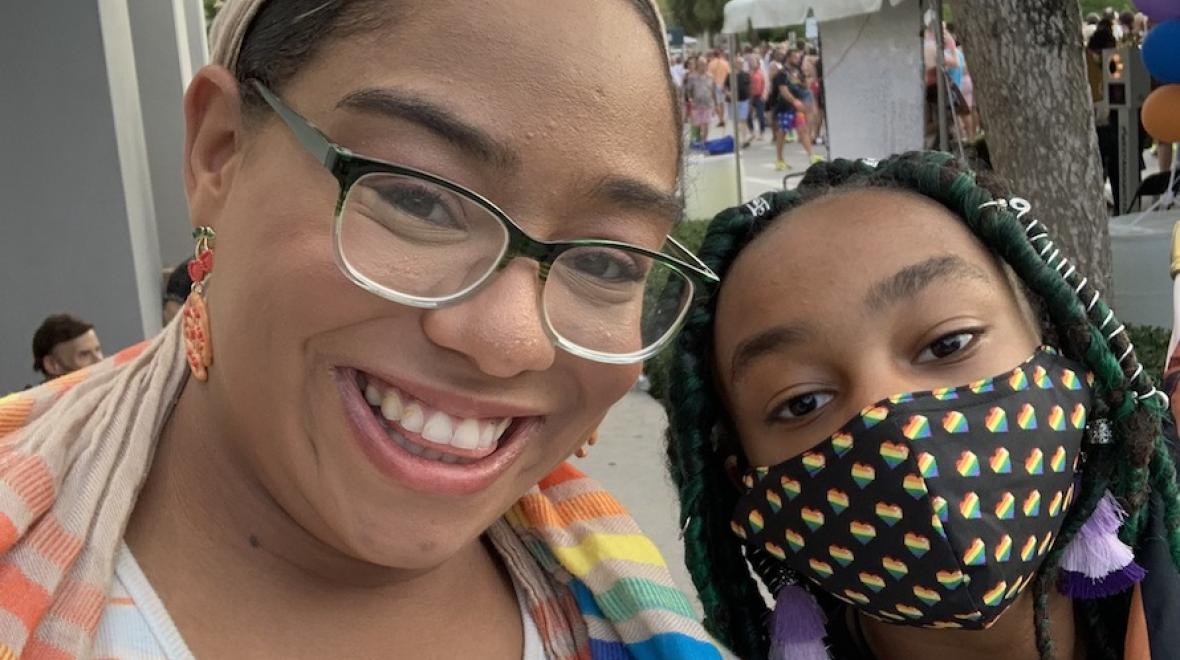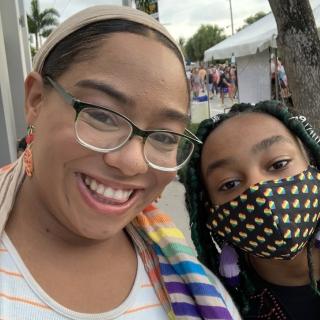
Photo:
Leigha Grimes and Amelia
National Coming Out Day (Oct. 11) serves as a time of reflection for me around my child’s coming out experience as LGBTQIA+ at age 11. When my child, Amelia, came out as pangender, it was a wonderful moment. To see them so fully secure in who they had always been and so willing to share that realization with me was hands-down one of the biggest highlights of my life as a parent. In the year since, our family has been on an explorative journey, learning more about Amelia's identity and how we as a family can be affirming and supportive. Children whose gender identity and sexuality don’t fit into the assumed cisgender and heterosexual boxes generally know early in their lives that there is something different about them, although it may take time for them to be able to explore their identity, to understand it and to fully express their authentic selves.
Coming out is difficult for adults, and it can be really hard for kids. Which is why it’s our job as parents to help guide our children through that process, so they can be who they truly are and live their lives to the fullest starting now.
As a parent who has helped my child navigate coming out, there are ways to support your children long before they openly tell you who they are. We are also here to support our children long after they come out to us and the folks around them, and there are ways to demonstrate our love and care for our kids as they grow into who they are.
Educate and hold space.
As a parent who actively teaches my child about diversity, equity and inclusion, I created space in my home for LGBTQIA+ history, representation and community long before my child came out. We did this through play, by choosing toys and books which feature diverse characters and families, and by celebrating key LGBTQIA+ dates such as National Coming Out Day in kid-friendly ways. Educating my child about the LGBTQIA+ community not only helped them understand that they were not alone, but also that there is a loving community of folks within this vast identity spectrum. Many folks grow up with internalized homophobia and transphobia, and a great way to combat that is through prioritizing LGBTQIA+ representation in the home and teaching acceptance as early as possible.
Be open to discussion.
For a child to come out to their parent, they need to feel safe having the discussion with them. By creating an open dialogue about LGBTQIA+ topics within my family I was able to help my child feel safe in initiating that conversation. When watching movies or television, we would talk about LGBTQIA+ characters openly, and LGBTQIA+ kid-friendly news such as when a celebrity they enjoy comes out. Encourage your children to ask questions about things they don’t understand, and then be open and honest in your responses to them. You can do this in an age-appropriate manner they can understand, demonstrating that you are open and happy to have these conversations. For those with younger children, genderbread.org is an excellent resource that helps break the concept of gender down into bite-sized pieces so discussions can start early.
Research and learn.
After your child comes out to you, it’s not uncommon for parents to feel confused and overwhelmed. It’s important to remember that your child doesn’t expect you to suddenly become an expert in all things LGBTQIA+, but rather to be open to learning about their identity. I found that proactively researching and learning about my child’s identity helped me be a better parent to them. By having a better understanding of who they were and what that meant for them in the scheme of life, I was able to better support them and help other people in our lives understand who they are. There are several online resources and groups such as PFLAG that can help parents understand their child.
Ask kind questions.
Your child is the expert on who they are, and as a parent you can actively listen and learn from what your child is telling you. Ask them respectful questions about their gender and sexual identity, and learn from their responses. As the parent of an LGBTQIA+-identifying child, what you say to them is just as important as what you hear from them. By actively listening and engaging in this form of conversation you will not only better understand your child and the experiences they are having, but you will also be able to better identify how you can help them as they learn and grow into their authentic selves.
Be an advocate.
One of the biggest jobs of being a parent is acting as your child’s advocate in school, society, and with friends and family. Most parents are already doing this for their child, but when your child comes out to you as LGBTQIA+, your job of advocating for them becomes a lot bigger — now you are advocating for their identity in all spaces, and, yes, for their right to equality. By being your child’s strongest advocate, you’re setting an important example that they will take into adulthood, when they’ll need to advocate for themselves.
By taking all the previous steps, you’ll be better able to advocate for your child. There are additional ways to surround yourself with a supportive community: Join a group for parents with LGBTQIA+ children; actively engage with the LGBTQIA+ community through events like Seattle Pride’s All Together Now fall event or its annual Seattle Pride Parade when it returns next spring; and enroll your child in groups with other LGBTQIA+ children.
Being a parent may become more complex when your child comes out, but it is also incredibly rewarding. Knowing that your child feels safe to express and live as their authentic selves means that as parents, we are doing a good job — something many of us don’t feel often enough. And coming out — regardless of age — makes our world and community a better place for us all.
I encourage all folks on the LGBTIQA+ spectrum to share their story on National Coming Out Day, because it enables children like mine to also come out and share their story. If you or your child feel comfortable doing so, I encourage you to share your story online in advance of All Together Now and National Coming Out Day. The stories — sometimes painful, sometimes humorous and always heartwarming — will be posted for sharing with the wider community for inspiration and to remind ourselves that we’re not alone.
It’s important that as parents, we open the door for our children and for others. The more folks on the LGBTQIA+ spectrum who share their story, the more other folks will feel safe living as their authentic selves.











